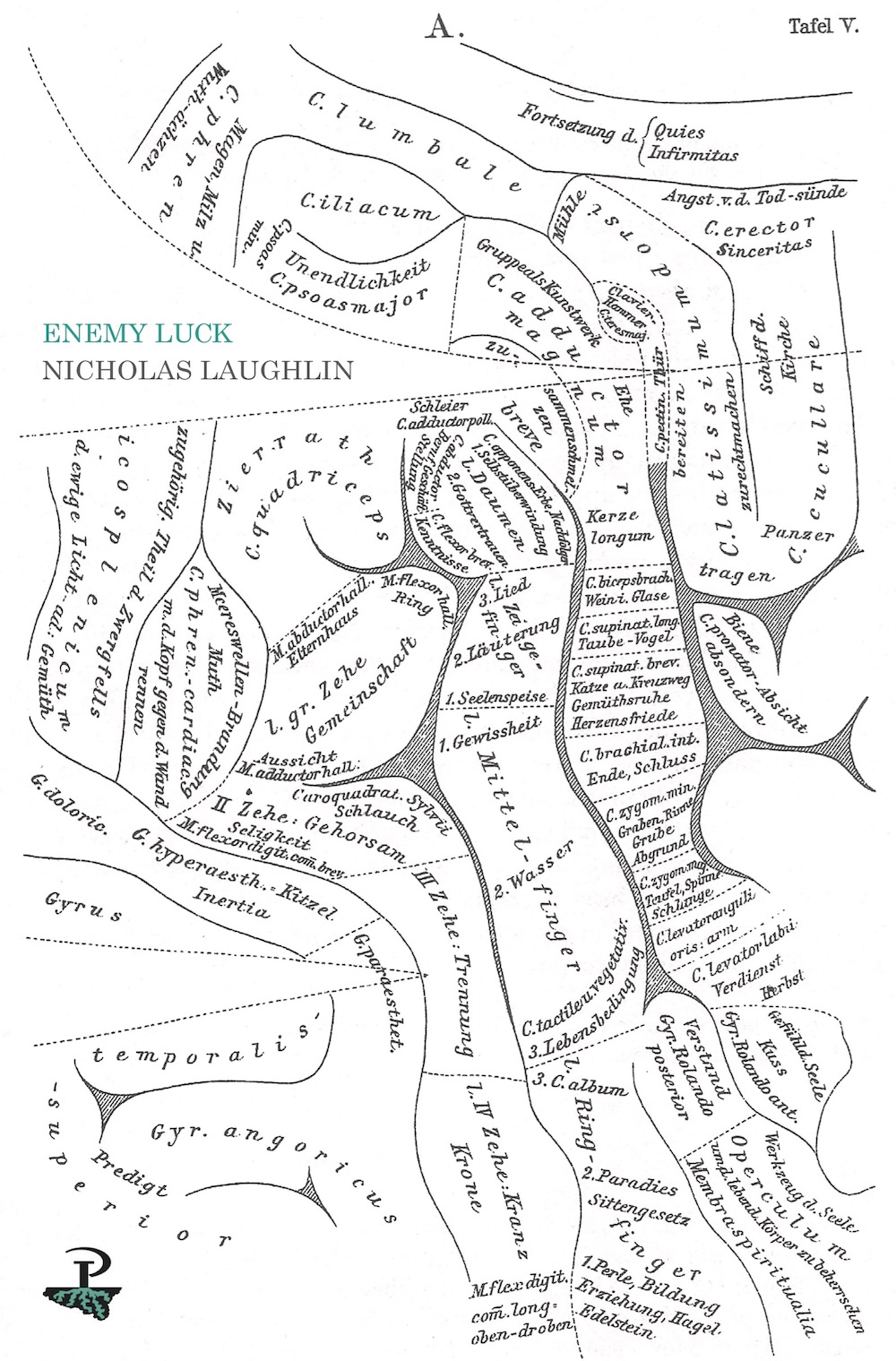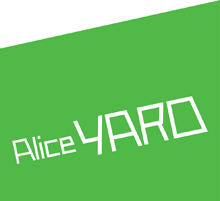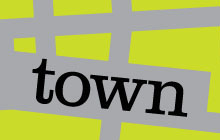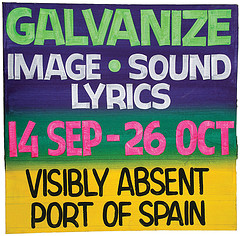Sunday, October 25, 2009
“It’s quite practical”
I have no use for the idea that what needs to be written will get written. I am fully aware that if practical circumstances allowed, I’d write more, and of better quality, that now probably won’t get written. I don’t mean this to sound mystical. It’s quite practical really. I think many good writers never make it and much good writing is lost or undone.
— My friend, collaborator, and co-editor Vahni Capildeo, interviewed today at the newish arts blog PLEASURE (first of a series of interviews with Trinidadian artists called “This/discourse/has/no/start(middle)nd”).
I have no use for the idea that what needs to be written will get written. I am fully aware that if practical circumstances allowed, I’d write more, and of better quality, that now probably won’t get written. I don’t mean this to sound mystical. It’s quite practical really. I think many good writers never make it and much good writing is lost or undone.
— My friend, collaborator, and co-editor Vahni Capildeo, interviewed today at the newish arts blog PLEASURE (first of a series of interviews with Trinidadian artists called “This/discourse/has/no/start(middle)nd”).
Wednesday, October 21, 2009
The day they “beautified” Hope
The spot where Tragarete Road meets Dundonald Street and Richmond Street is one of Port of Spain's in-between zones: just a little too far north to be downtown, too far east to be Woodbrook or Newtown — a neighbourhood that doesn't really have a name. One corner of the intersection is occupied by a gas station, another by a car dealership, a third by the old Strand cinema. Because the street grids to the north and south aren't quite aligned, in the intersection itself is a little traffic island, grassed over and roughly triangular. Thousands of people drive or walk past this place on an average weekday.
I'd wager not many pause to look at the piece of public art in the middle of the traffic island: a concrete sculpture, perhaps twenty feet tall, abstract in form. From a narrow base it widens into an organic diamond-like shape with an oval void at its centre, womb- or egg-like, then it tapers upwards into a kind of spire. I've often thought of it as a giant needle, its eye framing the view down Richmond Street to the sea. Perhaps thirty years ago, when it was still new, this object stood out in the city's bustle. Nowadays it recedes into the chaos of billboards and traffic.
This is Spirit of Hope, a work by the late Patrick Chu Foon (1931-1998), the artist responsible for many of Port of Spain's public sculptures, from the walking Gandhi (1969) in Kew Place to the Tribute to the Steelband Movement (1972) in Tamarind Square to Lord Kitchener (1994) outside the Harvard Club in St. James.
Spirit of Hope was installed in 1971, less than a decade after Independence and a year after the Black Power Uprising that expressed wide public discontent with Trinidad and Tobago's political and economic leadership. It was not a terribly hopeful point in Trinidad's recent history, to say the least, and I wonder if Chu Foon's sculpture was the manifestation of a genuine optimism or idealism, of an ironic detachment, or of an artist's inward-turning in the face of social breakdown and despair.
I thought of this today when I got a phone call from my friend Christopher Cozier, who had just driven down Tragarete Road and noticed that someone had painted over the sculpture in a shade of pastel green.
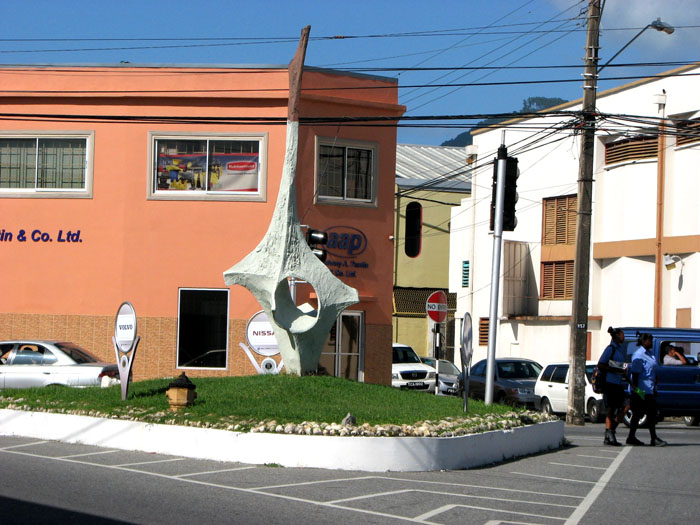
Georgia Popplewell and I decided to see this for ourselves. We drove into town, parked on Fraser Street, and walked round the corner. Spirit of Hope stood there looking sheepish in its new coat of hospital-wall green. No doubt some civic or corporate entity had decided this isolated object, rather dingy-looking after thirty-eight years in the car exhaust fumes, needed sprucing up. Except the paint ran out before the workmen finished their assignment, or else their ladder wasn't tall enough: the pale green stopped a good four feet below the tip of the spire. It's anyone's guess whether they'll return to finish the job.
I don't know what's worse: this act of vandalisation in the name of philistine "beautification"; or the fact that it was probably the result of considered good intentions (of the kind that pave the proverbial road to perdition); or even the fact that I feel slightly guilty bothering about the whole thing, in the midst of a prolonged nationwide social collapse with far more urgent symptoms. Why am I troubling myself about an obscure piece of public sculpture instead of picketing Whitehall or UDECOTT or the EMA or the office of the Leader of the Opposition or the constituency office of the MP I didn't vote for?
Maybe because this too is a telling symptom. It tells me how unaware we are, as citizens, of the civic spaces we live and work in, and how irresponsibly we behave towards them. It tells me how little respect we have for the work of our artists and thinkers, and how eagerly the powers-that-be package that work in more palatable forms. It tells me we're far too fond of quick, superficial solutions to our problems. Sculpture looking dirty? It would be hard work to research the artist's medium and methods, come up with a serious restoration plan, strip away older layers of unsympathetic paint, and rethink the architecture of that intersection to give the piece context, relevance, poise. Much easier to buy a tin of green paint.
Much easier to pay a few hundred million dollars to drop some big skyscrapers into Port of Spain — look, we have tall buildings, just like Miami! — than to think about the real strengths and flaws of our urban infrastructure, how to preserve the former and fix the latter. (Who cares if downtown still floods if it rains too hard for too long?) Easier to buy a giant blimp to hover over the country like the Eye of Sauron than to understand and address the real social inequalities that drive the crime and murder rate. Easier to erect a prime ministerial palace, it seems, than to build schools and put equipment into hospitals.
So this is what we do with the Spirit of Hope when it starts to look dingy: give it a cheap coat of paint, don't even bother to finish the job properly, throw up three-four advertising signs around it, and congratulate ourselves on "beautifying" the city — secure in the knowledge that almost nobody will notice.
The spot where Tragarete Road meets Dundonald Street and Richmond Street is one of Port of Spain's in-between zones: just a little too far north to be downtown, too far east to be Woodbrook or Newtown — a neighbourhood that doesn't really have a name. One corner of the intersection is occupied by a gas station, another by a car dealership, a third by the old Strand cinema. Because the street grids to the north and south aren't quite aligned, in the intersection itself is a little traffic island, grassed over and roughly triangular. Thousands of people drive or walk past this place on an average weekday.
I'd wager not many pause to look at the piece of public art in the middle of the traffic island: a concrete sculpture, perhaps twenty feet tall, abstract in form. From a narrow base it widens into an organic diamond-like shape with an oval void at its centre, womb- or egg-like, then it tapers upwards into a kind of spire. I've often thought of it as a giant needle, its eye framing the view down Richmond Street to the sea. Perhaps thirty years ago, when it was still new, this object stood out in the city's bustle. Nowadays it recedes into the chaos of billboards and traffic.
This is Spirit of Hope, a work by the late Patrick Chu Foon (1931-1998), the artist responsible for many of Port of Spain's public sculptures, from the walking Gandhi (1969) in Kew Place to the Tribute to the Steelband Movement (1972) in Tamarind Square to Lord Kitchener (1994) outside the Harvard Club in St. James.
Spirit of Hope was installed in 1971, less than a decade after Independence and a year after the Black Power Uprising that expressed wide public discontent with Trinidad and Tobago's political and economic leadership. It was not a terribly hopeful point in Trinidad's recent history, to say the least, and I wonder if Chu Foon's sculpture was the manifestation of a genuine optimism or idealism, of an ironic detachment, or of an artist's inward-turning in the face of social breakdown and despair.
I thought of this today when I got a phone call from my friend Christopher Cozier, who had just driven down Tragarete Road and noticed that someone had painted over the sculpture in a shade of pastel green.

Georgia Popplewell and I decided to see this for ourselves. We drove into town, parked on Fraser Street, and walked round the corner. Spirit of Hope stood there looking sheepish in its new coat of hospital-wall green. No doubt some civic or corporate entity had decided this isolated object, rather dingy-looking after thirty-eight years in the car exhaust fumes, needed sprucing up. Except the paint ran out before the workmen finished their assignment, or else their ladder wasn't tall enough: the pale green stopped a good four feet below the tip of the spire. It's anyone's guess whether they'll return to finish the job.
I don't know what's worse: this act of vandalisation in the name of philistine "beautification"; or the fact that it was probably the result of considered good intentions (of the kind that pave the proverbial road to perdition); or even the fact that I feel slightly guilty bothering about the whole thing, in the midst of a prolonged nationwide social collapse with far more urgent symptoms. Why am I troubling myself about an obscure piece of public sculpture instead of picketing Whitehall or UDECOTT or the EMA or the office of the Leader of the Opposition or the constituency office of the MP I didn't vote for?
Maybe because this too is a telling symptom. It tells me how unaware we are, as citizens, of the civic spaces we live and work in, and how irresponsibly we behave towards them. It tells me how little respect we have for the work of our artists and thinkers, and how eagerly the powers-that-be package that work in more palatable forms. It tells me we're far too fond of quick, superficial solutions to our problems. Sculpture looking dirty? It would be hard work to research the artist's medium and methods, come up with a serious restoration plan, strip away older layers of unsympathetic paint, and rethink the architecture of that intersection to give the piece context, relevance, poise. Much easier to buy a tin of green paint.
Much easier to pay a few hundred million dollars to drop some big skyscrapers into Port of Spain — look, we have tall buildings, just like Miami! — than to think about the real strengths and flaws of our urban infrastructure, how to preserve the former and fix the latter. (Who cares if downtown still floods if it rains too hard for too long?) Easier to buy a giant blimp to hover over the country like the Eye of Sauron than to understand and address the real social inequalities that drive the crime and murder rate. Easier to erect a prime ministerial palace, it seems, than to build schools and put equipment into hospitals.
So this is what we do with the Spirit of Hope when it starts to look dingy: give it a cheap coat of paint, don't even bother to finish the job properly, throw up three-four advertising signs around it, and congratulate ourselves on "beautifying" the city — secure in the knowledge that almost nobody will notice.
Saturday, October 17, 2009
Town on lower George Street
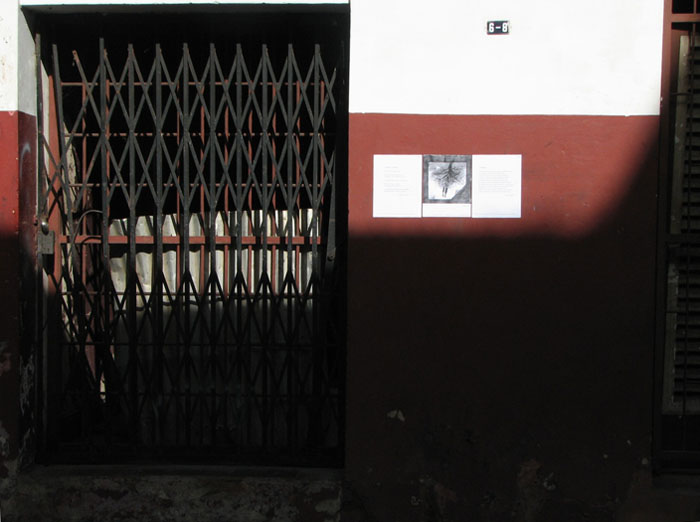
Broadsides from the first issue of Town, posted on the old Angostura Building, lower George Street, Port of Spain; 17 October, 2009

Broadsides from the first issue of Town, posted on the old Angostura Building, lower George Street, Port of Spain; 17 October, 2009
Friday, October 16, 2009
No license, no registration
Yesterday, Wesley Gibbings, president of the Association of Caribbean Media Workers (ACM), sent the following message to media associations around the region:
This is to advise of the imminent introduction of a Model Professional Services Bill to Caricom member states which calls for, among other things, the registration and licensing of media workers.
The bill is meant to 'regularise' and harmonise standards among professionals in a wide range of categories under the ambit of the CSME.
The subject was raised at a CSME workshop in St Lucia on October 12 by Caricom officials.
I have already advised that this matter is not subject to negotiation. It is a well-established fact that the licensing of journalists constitutes an outright threat to freedom of the press and other rights. There is also a growing body of international judicial precedents which determines its unlawful nature.
The ACM is moving quickly to nip this in the bud. We are inviting a senior Caricom official to discuss this matter with us at the forthcoming conference and fifth biennial general meeting in Grenada on December 10-12. Hopefully, the outcome will be a very clear message to have this withdrawn as a proposal to Caricom member states.
This is dangerous territory and I am urging all of us to use the tools at our disposal to publicise this issue and to act decisively to ensure the model Bill, especially as it relates to media workers, does not reach anywhere near our parliaments.
We will be mobilising international support for the campaign.
Georgia Popplewell links to a copy of the draft bill here. She urges her readers to publicise this issue, and I want to do the same. (Georgia also notes that the Media Association of Trinidad and Tobago, which forwarded Gibbings's message to its members last night via Facebook, does not have a "proper, public-facing web site" — their blog hasn't been updated since May 2007 — which, for a group of media professionals in AD 2009, is almost unbelievable. I want to add that although the ACM does have an informative website, they are yet to post anything about the Model Professionals Bill there.)
I also want to urge interested readers — and I hope you are all interested, not to mention alarmed at the possibility of regional legislation for registering journalists — to read the draft bill. It is meant to apply to a wide range of professions, but it takes no account of the circumstances and principles that make, say, medicine or engineering different to journalism. The draft bill, which is meant to be adopted by all Caricom states and leaves various blanks to be filled by respective governments, if applied to journalists and media workers, would:
= set up a professional council with some members chosen by media workers and some appointed by the government — the proportions of one to the other are left to individual governments;
= require all media workers to apply to that council for registration;
= further require all media workers to apply and pay for an annual license to practise their profession, with the fee to be determined by individual governments;
= require media workers to "display such License in a place in the facility where he operates, that is normally accessible to the public";
= forbid unlicensed persons from practising journalism, on pain of "summary conviction to a fine of [ ] or to imprisonment for [#] years". (Imagine the glee with which the Trinidad and Tobago Cabinet would fill in those blanks.)
With a few simple manipulations, this bill could essentially give Caricom governments the power to determine who can and cannot practise journalism. And it leaves citizen journalists — who the Caribbean mainstream media still don't quite understand or respect — in limbo. Would I be legally required to apply for registration and a license to continue writing on this blog? I don't "cover" "news" per se, but I have reported and commented on current events in the past, and insist on the right to do so in the future. Does that make me a journalist under the terms of the bill?
I don't have court clothes, and I don't intend to buy any. Please spread the word about this misguided piece of possible legislation and let's make it clear to Caricom that, as Gibbings writes, "this matter is not subject to negotiation."
Yesterday, Wesley Gibbings, president of the Association of Caribbean Media Workers (ACM), sent the following message to media associations around the region:
This is to advise of the imminent introduction of a Model Professional Services Bill to Caricom member states which calls for, among other things, the registration and licensing of media workers.
The bill is meant to 'regularise' and harmonise standards among professionals in a wide range of categories under the ambit of the CSME.
The subject was raised at a CSME workshop in St Lucia on October 12 by Caricom officials.
I have already advised that this matter is not subject to negotiation. It is a well-established fact that the licensing of journalists constitutes an outright threat to freedom of the press and other rights. There is also a growing body of international judicial precedents which determines its unlawful nature.
The ACM is moving quickly to nip this in the bud. We are inviting a senior Caricom official to discuss this matter with us at the forthcoming conference and fifth biennial general meeting in Grenada on December 10-12. Hopefully, the outcome will be a very clear message to have this withdrawn as a proposal to Caricom member states.
This is dangerous territory and I am urging all of us to use the tools at our disposal to publicise this issue and to act decisively to ensure the model Bill, especially as it relates to media workers, does not reach anywhere near our parliaments.
We will be mobilising international support for the campaign.
Georgia Popplewell links to a copy of the draft bill here. She urges her readers to publicise this issue, and I want to do the same. (Georgia also notes that the Media Association of Trinidad and Tobago, which forwarded Gibbings's message to its members last night via Facebook, does not have a "proper, public-facing web site" — their blog hasn't been updated since May 2007 — which, for a group of media professionals in AD 2009, is almost unbelievable. I want to add that although the ACM does have an informative website, they are yet to post anything about the Model Professionals Bill there.)
I also want to urge interested readers — and I hope you are all interested, not to mention alarmed at the possibility of regional legislation for registering journalists — to read the draft bill. It is meant to apply to a wide range of professions, but it takes no account of the circumstances and principles that make, say, medicine or engineering different to journalism. The draft bill, which is meant to be adopted by all Caricom states and leaves various blanks to be filled by respective governments, if applied to journalists and media workers, would:
= set up a professional council with some members chosen by media workers and some appointed by the government — the proportions of one to the other are left to individual governments;
= require all media workers to apply to that council for registration;
= further require all media workers to apply and pay for an annual license to practise their profession, with the fee to be determined by individual governments;
= require media workers to "display such License in a place in the facility where he operates, that is normally accessible to the public";
= forbid unlicensed persons from practising journalism, on pain of "summary conviction to a fine of [ ] or to imprisonment for [#] years". (Imagine the glee with which the Trinidad and Tobago Cabinet would fill in those blanks.)
With a few simple manipulations, this bill could essentially give Caricom governments the power to determine who can and cannot practise journalism. And it leaves citizen journalists — who the Caribbean mainstream media still don't quite understand or respect — in limbo. Would I be legally required to apply for registration and a license to continue writing on this blog? I don't "cover" "news" per se, but I have reported and commented on current events in the past, and insist on the right to do so in the future. Does that make me a journalist under the terms of the bill?
I don't have court clothes, and I don't intend to buy any. Please spread the word about this misguided piece of possible legislation and let's make it clear to Caricom that, as Gibbings writes, "this matter is not subject to negotiation."
Tuesday, October 13, 2009
Urbi et orbi
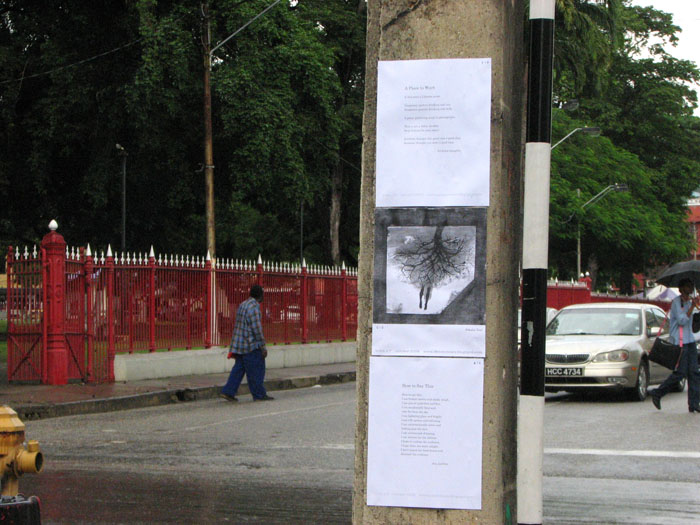
The corner of Abercromby Street and Hart Street, Port of Spain
A new project, but one I’ve been turning over in my head for some time: Town, a modest literary magazine, publishing poems, very short prose, and images in broadside editions, and also (of course) online.
This is partly (I will admit) a response to my continued anxiety and uncertainty about the future of the CRB; partly a way to experiment with different ways of no-budget, non-profit literary publishing; partly an opportunity to make things, attractive physical objects—in this case, simple 8½ x 11-inch broadsides run off on ordinary office equipment (huge thanks to my friend Sean Leonard for his help with this). We’ve printed a few dozen copies of each broadside, and begun posting them around Port of Spain on walls, fences, lampposts, and elsewhere.
I asked my friends Anu Lakhan and Vahni Capildeo, brilliant writers both, to be my co-editors. We agreed to include one poem by each of us in the first issue—if we’re going to ask other writers to let us stick their work up on public walls, we thought, we should be willing to do the same with our own. We also included a wry and very short fable by Kelvin Christopher James, a Trinidadian writer based in New York (whose work I’d previously published in the CRB), and three beautiful, haunting images by Nikolai Noel (1, 2, 3), excerpted from a larger work in progress.
Town launched last week: Anu and I traipsed round Port of Spain on Friday with a sheaf of broadsides and a roll of masking tape. We hope people will be surprised, perhaps delighted, perhaps confused by these fragments of poetry and art scattered through the city’s urban topography. We hope people will like them enough to steal the broadsides and take them home (by Saturday night one was already missing from the hoarding outside QRC). Those who don’t live or work in Port of Spain can read the full contents of the magazine at our website, and if you like what you find there, you can download PDFs of the broadsides, print them from your desktop, and post them wherever you please.
More about the hows and whys of Town here. Find out how to contribute here. See images of the broadsides posted around Port of Spain and elsewhere here. The first issue is all-Trinidadian, but for future issues there is no geographical restriction on contributing writers and artists: we simply want to publish good work, whether its effect is to surprise, to delight, or to confuse.
And here is my own contribution to the first issue of Town: a poem called “A Place to Start”.
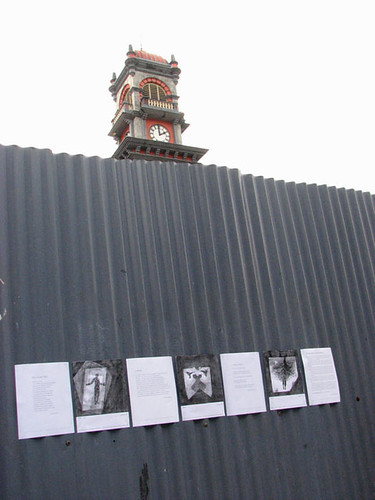
Outside QRC, Maraval Road, Port of Spain

The corner of Abercromby Street and Hart Street, Port of Spain
A new project, but one I’ve been turning over in my head for some time: Town, a modest literary magazine, publishing poems, very short prose, and images in broadside editions, and also (of course) online.
This is partly (I will admit) a response to my continued anxiety and uncertainty about the future of the CRB; partly a way to experiment with different ways of no-budget, non-profit literary publishing; partly an opportunity to make things, attractive physical objects—in this case, simple 8½ x 11-inch broadsides run off on ordinary office equipment (huge thanks to my friend Sean Leonard for his help with this). We’ve printed a few dozen copies of each broadside, and begun posting them around Port of Spain on walls, fences, lampposts, and elsewhere.
I asked my friends Anu Lakhan and Vahni Capildeo, brilliant writers both, to be my co-editors. We agreed to include one poem by each of us in the first issue—if we’re going to ask other writers to let us stick their work up on public walls, we thought, we should be willing to do the same with our own. We also included a wry and very short fable by Kelvin Christopher James, a Trinidadian writer based in New York (whose work I’d previously published in the CRB), and three beautiful, haunting images by Nikolai Noel (1, 2, 3), excerpted from a larger work in progress.
Town launched last week: Anu and I traipsed round Port of Spain on Friday with a sheaf of broadsides and a roll of masking tape. We hope people will be surprised, perhaps delighted, perhaps confused by these fragments of poetry and art scattered through the city’s urban topography. We hope people will like them enough to steal the broadsides and take them home (by Saturday night one was already missing from the hoarding outside QRC). Those who don’t live or work in Port of Spain can read the full contents of the magazine at our website, and if you like what you find there, you can download PDFs of the broadsides, print them from your desktop, and post them wherever you please.
More about the hows and whys of Town here. Find out how to contribute here. See images of the broadsides posted around Port of Spain and elsewhere here. The first issue is all-Trinidadian, but for future issues there is no geographical restriction on contributing writers and artists: we simply want to publish good work, whether its effect is to surprise, to delight, or to confuse.
And here is my own contribution to the first issue of Town: a poem called “A Place to Start”.

Outside QRC, Maraval Road, Port of Spain
Monday, October 05, 2009
Friday, October 02, 2009
The Englishman
Annai, March 2005
The Englishman had two sons, both by his Brazilian first wife, who was now dead. The elder son, he said, was twenty or twenty-one. He was in London, a student, studying film. The Englishman’s voice softened when he spoke of this elder son. There was a photograph of him in the library of the ranch house, a black-and-white photograph in a silver frame. It was a formal portrait, taken in a studio. The son — his features delicate, his hair neatly parted in an old-fashioned style, his mouth barely smiling — looked something like a film-star of the 1930s. There was a soft sheen about him, almost like a halo, a silvery bloom like the manifestation of something like sanctity.
This son, the Englishman said, would be returning to the ranch in July with some of his film-school friends. They would have their cameras, their equipment. They would make a film about South America, travelling south by motorcycle, or perhaps Land Rover. He was a hard-working boy, the Englishman said, with two jobs in London to pay for his studies. And though he didn’t say it, it was clear this elder son would return to the ranch only for short visits. He had grown up here, but his life was now elsewhere, in the city his father had fled forty years before. The soft silvery halo of his black-and-white portrait somehow confirmed this, was somehow a sign of his translation into that city, that life across the ocean.
The Englishman’s younger son was named George. Or perhaps it was Jorge. But everyone called him Georgie — or “Jargie”, which is how it sounds in a Guyanese accent. Jargie looked nothing like his brother. His black hair was long and shaggy, and he had a scraggly beard. One of his front teeth was chipped. He had a dark tan. He rarely looked anyone in the eye, and he said little, at least while his father was nearby. He may have been nineteen or twenty, but he looked older. He had the heaviness of gesture of a man of thirty, easy in the ways of the world, but when he spoke it was like a boy, with a note of sullenness. He often seemed unwashed, at all hours, as though he had just been labouring at some heavy job involving dirt and grease.
Jargie seemed angry when his father was nearby, and eager to be somewhere else, at some task. The Englishman didn’t seem to notice this. “A good son, a faithful son,” the Englishman said. “I couldn’t ask for a more faithful son,” but when he spoke to Jargie it was in questions and orders.
“The plane came in this morning. Did it bring our package? Yes? Did you check it? No? So how are we to know what message to send back? You must check it at once, and come to my office to tell me if the part is there. Without it, how will we fix the second truck? Good? Off you go, then.”
Jargie replied in grunts, and hardly raised his eyes from the ground. He strode off.
“I couldn’t ask for a more faithful son.”
Later, driving the Land Rover, with his father back at the ranch, Jargie spoke confidently, almost boastfully, of his work at the ranch, the vehicles, the horses. The men of the village seemed to like him but also to be a little afraid of him. You could tell by the way Jargie spoke to them that he was proud of this.
He never mentioned his brother.
Annai, March 2005
The Englishman had two sons, both by his Brazilian first wife, who was now dead. The elder son, he said, was twenty or twenty-one. He was in London, a student, studying film. The Englishman’s voice softened when he spoke of this elder son. There was a photograph of him in the library of the ranch house, a black-and-white photograph in a silver frame. It was a formal portrait, taken in a studio. The son — his features delicate, his hair neatly parted in an old-fashioned style, his mouth barely smiling — looked something like a film-star of the 1930s. There was a soft sheen about him, almost like a halo, a silvery bloom like the manifestation of something like sanctity.
This son, the Englishman said, would be returning to the ranch in July with some of his film-school friends. They would have their cameras, their equipment. They would make a film about South America, travelling south by motorcycle, or perhaps Land Rover. He was a hard-working boy, the Englishman said, with two jobs in London to pay for his studies. And though he didn’t say it, it was clear this elder son would return to the ranch only for short visits. He had grown up here, but his life was now elsewhere, in the city his father had fled forty years before. The soft silvery halo of his black-and-white portrait somehow confirmed this, was somehow a sign of his translation into that city, that life across the ocean.
The Englishman’s younger son was named George. Or perhaps it was Jorge. But everyone called him Georgie — or “Jargie”, which is how it sounds in a Guyanese accent. Jargie looked nothing like his brother. His black hair was long and shaggy, and he had a scraggly beard. One of his front teeth was chipped. He had a dark tan. He rarely looked anyone in the eye, and he said little, at least while his father was nearby. He may have been nineteen or twenty, but he looked older. He had the heaviness of gesture of a man of thirty, easy in the ways of the world, but when he spoke it was like a boy, with a note of sullenness. He often seemed unwashed, at all hours, as though he had just been labouring at some heavy job involving dirt and grease.
Jargie seemed angry when his father was nearby, and eager to be somewhere else, at some task. The Englishman didn’t seem to notice this. “A good son, a faithful son,” the Englishman said. “I couldn’t ask for a more faithful son,” but when he spoke to Jargie it was in questions and orders.
“The plane came in this morning. Did it bring our package? Yes? Did you check it? No? So how are we to know what message to send back? You must check it at once, and come to my office to tell me if the part is there. Without it, how will we fix the second truck? Good? Off you go, then.”
Jargie replied in grunts, and hardly raised his eyes from the ground. He strode off.
“I couldn’t ask for a more faithful son.”
Later, driving the Land Rover, with his father back at the ranch, Jargie spoke confidently, almost boastfully, of his work at the ranch, the vehicles, the horses. The men of the village seemed to like him but also to be a little afraid of him. You could tell by the way Jargie spoke to them that he was proud of this.
He never mentioned his brother.
Subscribe to:
Posts (Atom)


